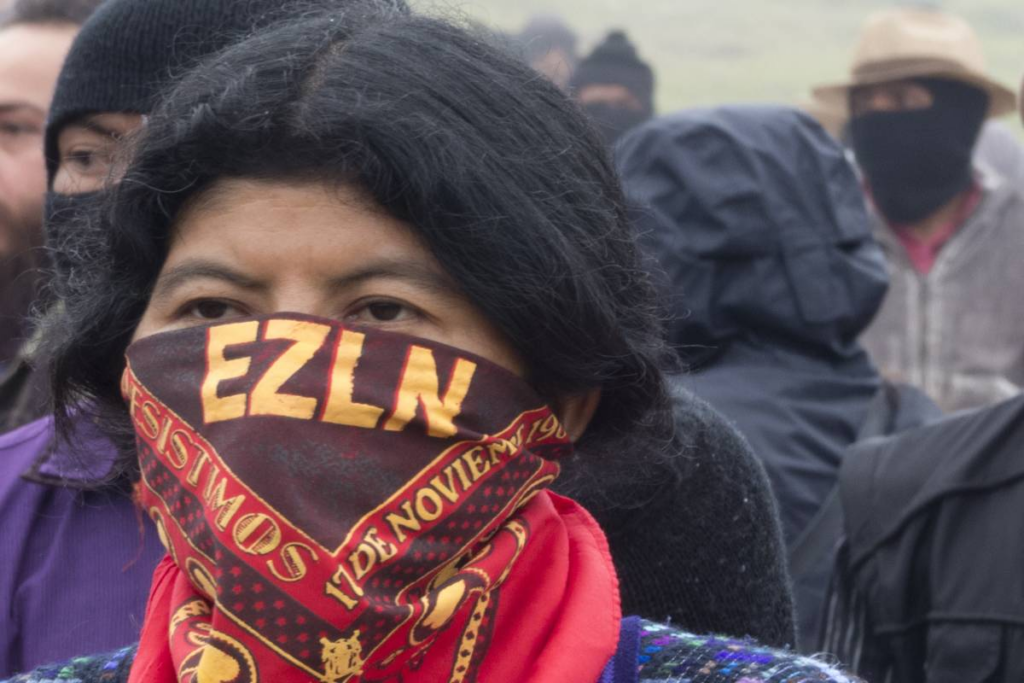
The EZLN is approaching its 30th anniversary in a context of crime in Chiapas, in which the Zapatistas themselves warn about the climate of violence and organize an internal restructuring in their territories to increase their security. Photo: Orsetta Bellani
“Chiapas on the Verge of a Civil War” is the title of a communiqué that the Zapatista Army of National Liberation (EZLN) released in September 2021. More than two years later, the state’s analysts are divided between those who think it was a premonition and those who consider it an inadequate definition. What everyone in Chiapas agrees on, except Governor Rutilio Escandón, is that after the COVID-19 pandemic and within the framework of the 2021 state elections, it fell into a serious security crisis that continues to worsen.
The EZLN is approaching its 30th anniversary in this context. When inviting national and international civil society to participate in its celebrations, which will take place between December 30th and January 2nd, Subcommander Moisés wrote: “It is our duty, at the same time as inviting you, to discourage you. Contrary to what the official press, self-proclaimed cool-progre-good vibe, reports and misinforms, the main cities of the southeastern Mexican state of Chiapas are in complete chaos. The municipal presidencies are occupied by what we call “legal hitmen” or “Disorganized Crime.” There are blockades, assaults, kidnappings, protection rackets, forced recruitment, shootings. This is the effect of the patronage of the state government and the dispute over the posts that is in process. They are not political proposals that are presented, but rather criminal societies. So, of course we tell you that, unlike other years, it is not safe. So we do want you to come, although we do not recommend it.”
Chiapas stands out for the speed with which the perception of insecurity among its inhabitants increased, in ten years it grew by 34%, according to INEGI.
Generalized Violence in Chiapas
Two months before the Zapatista communiqué “Chiapas on the Verge of Civil War”, in July 2021, what had been brewing for years exploded. After the murder of the social defender and catechist Simón Pedro Pérez of Las Abejas de Acteal, the population of Pantelhó rebelled and self-defense groups were born. It became ocvious that in the Chiapas Highlands region there is not only a historical presence of armed groups, which the caciques use to displace people and grab land, but that organized crime groups from other states of the Republic operate.
The two phenomena were hybridizing. “Organized crime is eating up the power groups that exist in the territory, it is like a transnational that is incorporating local stores,” explains Mario Ortega from the Fray Bartolomé de Las Casas Center for Human Rights (Frayba). This also happened with many organizations that ended up dissolving into supposed social organizations created and imposed by organized crime.
In July 2021, while violence broke out in Pantelhó and thousands of people were forced to flee, in Frontera Comalapa, about six hours away, something happened that did not usually happen in Chiapas: clashes between cartels. The dispute over the territory spread from Comalapa to the other municipalities in the border area with Guatemala and the Sierra Mariscal, reaching the Northern Zone and the Lacandon Jungle.
The local press documents, month after month, how new municipalities become part of the disputed region. It is common to read notes about missing people, dismembered bodies and entire displaced towns. The violence brought not only fear but also economic problems: farmers cannot reach their plots or market their products, shortages became frequent in the markets and due to insecurity some ecotourism centers that fed entire communities closed.
The context is not easy to read and there are many gray areas: it is increasingly difficult to understand whether the ejidatarios blocking a highway have a genuine interest or are forced by organized crime, and it became difficult to discern a spontaneous peace march from one driven by one cartel to harm the other.
The concern of the people of Chiapas is that the levels of violence could increase as the next government elections approach in 2024. “The cartels target the weakest controllable structure in the territories, which are the ejidos and municipalities: from there they can control everything in political, economic, financial, road and public force terms,” says Gustavo Castro, coordinator of the civil association Otro Mundos. “Their traffic involves the control of the territory and their objective is to dominate each municipal presidency.” Already in 2021, elections were canceled in six municipalities in Chiapas due to insecurity.
War of Attrition
According to Gustavo Castro, starting in 2000 the consequences of the North American Free Trade Agreement (NAFTA) began to be felt: the measures promoted by the government, including the PROCEDE program, caused a crisis in the countryside that weakened the territorial control of the EZLN as well as the ejidos and communal property, which served as a barrier to the entry of criminal organizations.
The presence of the EZLN, which prohibited planting narcotics in its communities, continues to represent a problem for the territorial expansion plans of criminal organizations. However, there is no known direct attack by organized crime against Zapatista vilages.
This does not mean that rebel communities are victims of attacks. Gustavo Castro says that this is no longer the paramilitarism of the ’90s, when the Secretariat of National Defense (SEDENA) “secretly trained certain sectors of the civilian population” to destroy the EZLN, doing its dirty work: they sowed terror in the civilian population, displaced thousands of people, committed massacres.
After the Acteal massacre in 1997, the national and international uproar was so great that the counterinsurgency war changed its face and became a “comprehensive war of attrition,” says Frayba. The noticeable actions were replaced by less visible, but continuous operations, which wear down the population, day after day: gunshots in one community, families displaced from another, young people imprisoned without evidence.
José Díaz Gómez, a farmer and support base of the EZLN, was arrested on November 25th, 2022 and tortured by the police, who accused him of robbery with violence. Another Zapatista, Manuel Gómez Vázquez, was accused of the murder of a man, while Manuel was at his house with his family. On November 16th, 2023, the 22-year-old Zapatista was acquitted because the Prosecutor’s Office could not present evidence; he had already spent almost three years in preventive detention.
“In 2000, with the change of government, power relations were restructured and there was a change in the counterinsurgency strategy. Cooptation is prioritized: many organizations in struggle end up being allies of the State, they become corporatized and receive benefits, including political positions for their leaders, at the municipal or even state level as deputies. These organizations contest with others, such as the EZLN, for their social base,” says Mario Ortega del Frayba. “At the same time, armed violence against the EZLN continues. There is no direct impulse at the federal level, but there is permissiveness, as in the case of the Ocosingo Regional Coffee Growers Organization (ORCAO), which is one of the corporatist organizations that were co-opted.”
From 2019 to date, ORCAO, which until the end of the 90s and before receiving social programs was linked to Zapatismo, carried out more than 110 armed attacks against the communities of the Zapatista region of Moisés and Gandhi, in addition to burning schools and coffee warehouses. It kidnapped and tortured EZLN support bases and in May 2023. One of them, Jorge López Santiz, was shot in the chest. He spent ten days in intensive care and the functioning of his intestine was affected.
In a situation of generalized violence like the one that exists in Chiapas, the Zapatistas are also victims of attacks that are not specifically directed against them. This is the case of Aldama, victim for about four years of constant attacks by an armed group from Chenalhó, which caused eight deaths, 27 wounded and more than two thousand displaced persona, some of them Zapatistas.
In recent weeks, the EZLN issued a series of statements in which it announced an internal restructuring that would not be complete until the autonomous government in its territories became more effective and horizontal and its security increased.
Sub-commander Moisés explains: “The structure and disposition of the EZLN has been reorganized in order to increase the defense and security of the peoples and Mother Earth in case of aggressions, attacks, epidemics, invasion of companies that prey on nature, military occupations. partial or total, natural disasters and nuclear wars. We have prepared so that our people survive, even isolated from each other. As in these 30 years, our fight is for life.”
* It is the 40th anniversary of the EZLN and the 30th anniversary of the EZLN uprising (Schools for Chiapas).
Original text and photo by Orsetta Bellani at https://www.animalpolitico.com/estados/ezln-aniversario-chiapas-crisis-seguridad
Translated by Schools for Chiapas.
